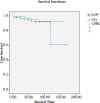Comparing 5-year Outcomes of Aorta-Coronary Bypass Surgery and Percutaneous Coronary Intervention Performed with New-Generation Drug-Eluting Stents in Non-Diabetic Patients with Multivessel Acute Coronary Syndrome Patients and Intermediate Syntax Score
- PMID: 32733761
- PMCID: PMC7384501
- DOI: 10.5222/MMJ.2020.80270
Comparing 5-year Outcomes of Aorta-Coronary Bypass Surgery and Percutaneous Coronary Intervention Performed with New-Generation Drug-Eluting Stents in Non-Diabetic Patients with Multivessel Acute Coronary Syndrome Patients and Intermediate Syntax Score
Abstract
Objective: Our main objective is to determine the difference between patients undergoing CABG and PCI with new-generation drug-eluting stents who were non-diabetic during the course of a multivessel acute coronary syndrome (ACS) and intermediate SYNTAX score.
Methods: Between 2012 and 2014, we retrospectively evaluated 1011 non-diabetic patients with ACS in a single center. The patients were followed up up to 5-years. All- cause mortality, cardiac death, myocardial infarction, stroke, revascularization and stent thrombosis were recorded accordingly.
Results: A total of 516 (51%) patients were included in the PCI group and 495 patients (49%) in the CABG group. Stroke occurrence (PCI group: 0.8%, and CABG group: 2.6%, p=0.022), requirement for recurrent revascularizations (PCI group: 13.6%, and CABG group: 8.1%, p=0.005) and the MACE percentage (PCI group: 20.3%, and CABG group: 14.5%, p=0.015) were statistically significant between two groups. However, there was no statistical significance difference between two groups in terms of primary endpoints including death, MI, and stroke (PCI group: 10.9%, and CABG group: 8.3%, p=0.165) and all-cause mortality PCI group 6.2%, and CABG group: 4.7%, p=0.298).
Conclusion: There was no difference in all-cause mortality and myocardial infarction between the PCI and the CABG groups during 5-year follow-up. The frequency of repeated revascularizations was lower in the CABG group than the PCI group. In contrast, the stroke rates were higher in the CABG group.
Amaç: Araştırmadaki temel amacımız, çok damarlı akut koroner sendromu (ACS) ve ara değer SYNTAX puanı bulunan süreçte diyabetik olmayan CABG ve (yeni nesil ilaç salınımlı stentli) PCI geçiren hastalar arasındaki farkı saptamaktır.
Yöntem: 2012-2014 arasında tek merkezde, ACS’li 1011 diyabetik olmayan hastayı retrospektif olarak değerlendirdik. Hastaların takibi 5 yıla kadar yapılmıştır. Tüm nedenlere bağlı ölüm, kardiyak ölüm, miyokard enfarktüsü, inme, revaskülarizasyon ve stent trombozu buna göre kaydedilmiştir.
Bulgular: 516 (%51) hasta PCI grubuna, 495 hasta (%49) CABG grubuna alınmıştır. İnme oluşumu (PCI grubunda %0,8 ve CABG grubunda %2,6, p=0,022), tekrarlanan revaskülarizasyon gereksinimi (PCI grubunda %13,6 ve CABG grubunda %8,1, p=0,005) ve MACE yüzdeleri (PCI grubunda %20 ,3, CABG grubunda %14,5, p=0,015) iki grup arasında istatistiksel olarak anlamlı derecede farklı bulunmuştur. Öte yandan, ölüm, MI ve inme (PCI grubunda %10,9 ve CABG grubunda %8,3, p=0,165) ve tüm nedenlere bağlı mortalite (PCI grubunda %6,2, CABG grubunda %4,7, p=0,298) dahil olmak üzere birincil sonlanım noktaları arasında iki grup karşılaştırıldığında istatistiksel açıdan anlamlılık fark yoktur.
Sonuç: Beş yıllık takip sırasında tüm nedenlere bağlı mortalite ve miyokart enfarktüsü açısından PCI ile CABG grupları arasında anlamlı fark bulunmamıştır. Tekrarlanan revaskülarizasyon ise CABG grubunda PCI grubundan daha düşüktür. Bunun aksine, inme oranları CABG grubunda daha yüksek çıkmıştır.
Keywords: CABG; PCI; acute coronary syndrome; mortality; non-diabetic; stent.
Copyright Istanbul Medeniyet University Faculty of Medicine.
Conflict of interest statement
Conflict of interest: The authors declare that they have no conflict of interest.
Figures
References
-
- Fihn SD, Gardin JM, Abrams J et al. ACCF/AHA/ ACP/AATS/PCNA/SCAI/STS guideline for the diagnosis and management of patients with stable ischemic heart disease: executive summary: a report of the American College of Cardiology Foundation/American Heart Association task force on practice guidelines, and the American College of Physicians, American Association for Thoracic Surgery, Preventive Cardiovascular Nurses Association, Society for Cardiovascular Angiography and Interventions, and Society of Thoracic Surgeons [published correction appears in Circulation. Circulation. 2012;2012;126:3097–137. 2014 Apr 22;129(16):e462. - PubMed
-
- Fihn SD, Blankenship JC, Alexander KP et al. ACC/ AHA/AATS/PCNA/SCAI/STS focused update of the guideline for the diagnosis and management of patients with stable ischemic heart disease: a report of the American College of Cardiology/American Heart Association Task Force on Practice Guidelines, and the American Association for Thoracic Surgery, Preventive Cardiovascular Nurses Association, Society for Cardiovascular Angiography and Interventions, and Society of Thoracic Surgeons. J Am Coll Cardiol. 2014;2014;64:1929–49. - PubMed
-
- Authors/Task Force members, Windecker S, Kolh P et al. 2014 ESC/EACTS Guidelines on myocardial revascularization: The Task Force on Myocardial Revascularization of the European Society of Cardiology (ESC) and the European Association for Cardio-Thoracic Surgery (EACTS) Developed with the special contribution of the European Association of Percutaneous Cardiovascular Interventions (EAPCI) Eur Heart J. 2014;35:2541–619. - PubMed
-
- Riley RD, Lambert PC, Abo-Zaid G. Meta-analysis of individual participant data: rationale, conduct, and reporting. BMJ. 2010;340:c221. Published 2010 Feb 5. - PubMed
LinkOut - more resources
Full Text Sources
Miscellaneous

